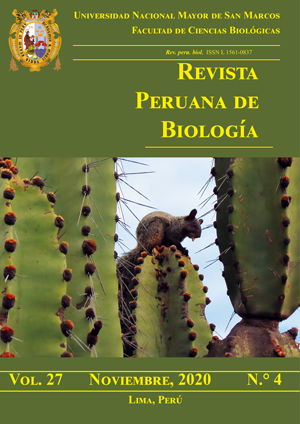Phenotypic diversity of native potatoes in indigenous communities of the Pastos ethnic group (Nariño, Colombia): Ecological agriculture for food security and rural development
DOI:
https://doi.org/10.15381/rpb.v27i4.18020Keywords:
Native potatoes, moorland, traditional agriculture, shagra, agrobiodiversityAbstract
This paper describes the in situ conservation mode of the production system and phenotypic diversity of native potatoes in the indigenous reserves of the Los Pastos ethnic group. Two methodologies were used in the study: 1) a characterization of traditional production systems through participatory action research in the indigenous reservations of Males Córdoba and El Gran Cumbal, and 2) a morphological characterization of native potatoes through 26 qualitative descriptors. We found that 16% families cultivate at least one variety of native potato, distributed in sub-páramo and páramo areas between 2,900 and 3,500 m above sea level, in an autochthonous production agroecosystem named “Shagra”, with traditional minimum soil tillage management (“Guachado”) and cultivated areas less than 600 m2. Thirty eight varieties were identified and classified in two types, according to the indigenous people: chauchas and guatas, representing 65 and 35%, respectively. The cluster analysis identified seven groups, discriminated by chauchas, guatas, place of origin, and morphological characteristics. These indigenous communities preserve their traditional knowledge and genetic resources by growing a diversity of native potatoes in association with other Andean crops, which contributes to food security and sovereignty.
Downloads
Downloads
Published
Issue
Section
License
Copyright (c) 2020 María Gladis Rosero Alpala, William Armando Tapie, Deisy Alexandra Rosero Alpala

This work is licensed under a Creative Commons Attribution-NonCommercial-ShareAlike 4.0 International License.
AUTHORS RETAIN THEIR RIGHTS:
a. Authors retain their trade mark rights and patent, and also on any process or procedure described in the article.
b. Authors retain their right to share, copy, distribute, perform and publicly communicate their article (eg, to place their article in an institutional repository or publish it in a book), with an acknowledgment of its initial publication in the Revista Peruana de Biologia.
c. Authors retain theirs right to make a subsequent publication of their work, to use the article or any part thereof (eg a compilation of his papers, lecture notes, thesis, or a book), always indicating its initial publication in the Revista Peruana de Biologia (the originator of the work, journal, volume, number and date).


















